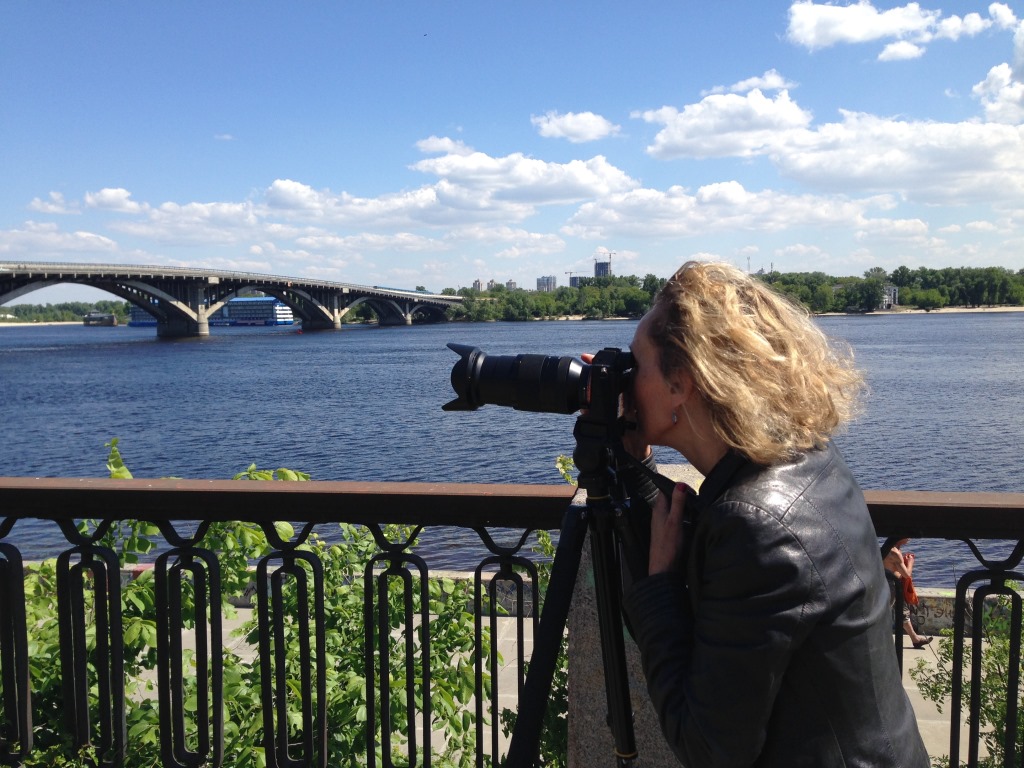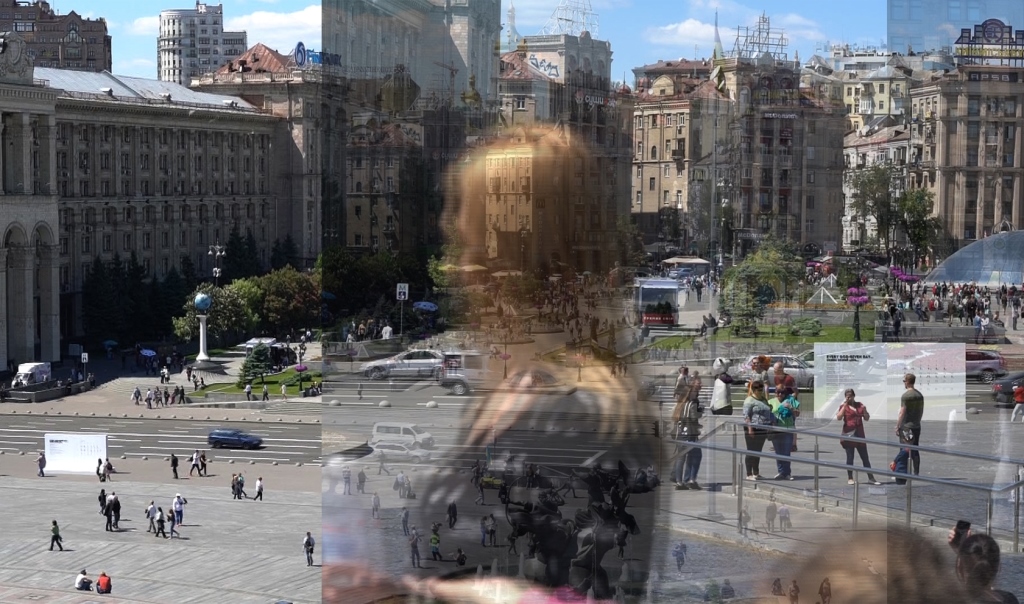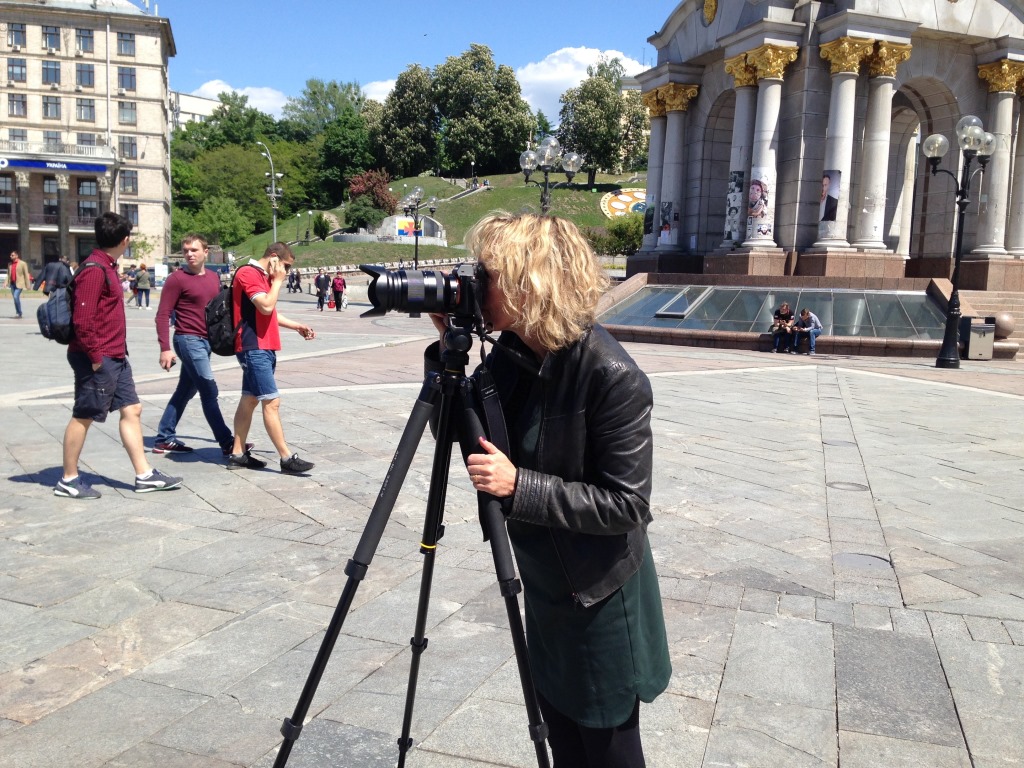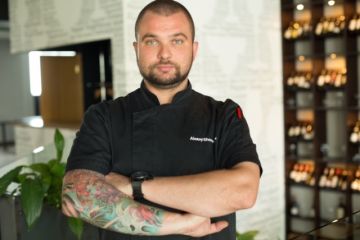Catherine, can you please tell us about your project in Ukraine.
Catherine: Its title is “Voices in Kyiv”. Even though I am a visual artist I’d like to stress on the sound aspect and it is going to be a combination of video, sound and photography composition. There will be recomposed photos, because I work with photography like a painter. I take details of the city, buildings, streets, people, crowd (I like movement of people and especially women on the streets) and all the means of transportation (buses, Metro, boats, bridges). The city is the body and all these details like people and cars are veins of this body making it alive. In a metaphorical way it is beautiful. In fact, it is more about my dreams and my visual perception of the city than a real picture. The exhibition will be presented this winter in Kyiv, most probably in December, in Taras Shevchenko museum. 
Nowadays almost everyone has a gadget with camera and can create some photos. But what differs real photography as a part of Visual Arts from everyday middle-brow photography?
Catherine: It is a good question. I started my work in the 80s, so, of course, that time there were no gadgets like now. It was a different world. Now, of course, I have to take a note that things are different but as to your question, the main difference is that the artist has a vision. I like to think about my creation as a parallel of my life. I am not doing a picture today just to share it in social networks. I do pictures because it is a need to express what I have in my mind, some ideas. It is a deep need like to breath. And this vision is beating inside of me. It is my way to be alive and to express the reality. This vision needs to be expressed in my work. So, for me the photography is not just a memory or note to my friends in Instagram but the meaning of my life. It makes me so happy. I am visited by thoughts, visions and may be even by angel who says to me what to shoot and I feel such a joy. This is my truth and I don’t have another one. As Vasily Kandinsky said in his “The spirituality in art” book: “The beautiful appears from inner spiritual necessity. The beautiful is something that is beautiful internally”. All this gadgets help to inform your friends about you and to make it fast. But I am interested in duration.
Photography was created to stop the moment, and time freezing was the main idea behind it. But in your works it is not just about time, it is even more about motion of the moment, people and cities. You make the picture alive. What do think about the future photography? How will it look like, if it has future at all?
Catherine: Yes, I’ve never done my photography with the reason to stop the moment even when I started in the 80s. In the beginning there were triptychs of landscapes, then it was about movements, and now I am interested in different episodes, different movements that follow each other and in creation of compositions. I like repetition and declination. I want to make the moment last long. As we talk about the future of photography, I don’t think that all these things are in contradiction with each other, they are not enemies. When photography appeared, people thought that painting would die. But this art still coexists with photography and each has its own identity and charm, and this is good. Technically no matter how far the photography will develop there will be still place for classic photography. Even now I have a lot of friends, very famous photographers who still follow the traditional process of photography making. And young generation is interested to discover the old technics now as well. This is a need for the tactile process like in the 19th century. I think it is interesting to go back to that. So, I think that no matter how far technologies go, the old and past technics will coexist. 
It is not a secret that nowadays most of population lives in the cities, not villages as it was in Middle age. And you are concentrated on city life in your works. Do you think that your works help people to see themselves from a different angle, to understand better our urban nature? How does the metropolis change us?
Catherine: Well, journalists used to make a joke of me saying: “Catherine Gfeller is interested in the cities of not less than 15 million people”. It is partially true. The bigger the better for me - I feel big city alive full of people with their destinies, moving like a very powerful energy, like alive body. I don’t want to be dramatic but to give a joyful vision about this, to give colors, movements and shapes to this big body. I want to create a good composition, something tasty, with the meaning. That is why vision is important. If you have vision inside, you have to adapt it to the world and then you can call it your melody, your style, your voice. That is what I am doing in my life, creating my melody. Someone likes it, someone doesn’t. This is my style. And I always meet some people who like it and with whom I can share it. So, I feel that what I am doing is not useless. 
In your works all cities are alive and have their own character. What is the character of Kyiv? How would you describe it? What are your impressions?
Catherine: I did not have much time to explore it. My work is shooting but almost unconsciously, rapidly and within next weeks we look at the pictures at the computer and then understand why I did that. But so far I can tell you that it is a difficult city to photograph because it is not as obvious as New-York or Los-Angeles. It is very hidden, very secret and multi-layered. You have to know the right door to discover it. And at first it is difficult to find the marks that lead you to the right doors. Even in the books about Kyiv it is not clear how the districts have been put together like in Paris, for example.
But maybe it is due to a fact that Kyiv is 1535 years old. It was rebuilt, destroyed and repaired many times.
Catherine: Yes, this can be a reason. And that is why it is hard to read all the layers and they are mixed. It is not like Rome, for example. And I don’t speak the language I can’t read the signs and it is a bit difficult for me. And I thought about my project in Kyiv, I want to develop stories using words and sentences to have visual part and to make it clearer. Only visual component is not enough to understand Kyiv. 
But people make the city to have not only character but soul as well. What do you think about Kyiv dwellers? Even if you had not talked to them but you saw them on the streets of the city. Please, share your impressions.
Catherine: I did not meet a lot. I’ve been to many, many cities, as you know. I will tell you about the crowd more than about people. I can feel that people on the streets here are a bit closed, they don’t talk to me, they don’t interact with me. I have European appearance so people may think that I am from Ukraine. So, there should not be any barrier like it could be with foreigner from China or other parts of the world. Thanks to my camera, I look special and people can be curious in what I am doing. But anyway, they don’t interact with me. In the other countries people always come to me and ask where I am from and what I am doing. And here it is different. I don’t know why and how I should interpret that – are they shy, indifferent or just don’t care? Only police talked to me when I was shooting in Metro; they said that it was forbidden. I was filming the metro on the bridge. I explained them that I was not a journalist but the artist, so they gave me 1 minute to shoot :-)
I would say that in this sense Kyiv probably reflects the nature of Ukrainian people. We are hospitable but we are not ready to open our soul from the very first moment. We need time to break the ice.
I think it because of our Soviet past, if we talk about older generation. People are very closed. During Soviet times there was the “Iron Curtain” and it was even forbidden to communicate with foreigners and to make contacts. The authorities could even put you in prison for that kind of “friendship”. Young generation is different but still you can meet this type of behavior due to our genetic heritage. If you stay here for a bit longer things would be different for you.
Catherine: Yes, it makes sense. I had the experience with the student who assisted me in making photos. His name is Akim, he is 19 and he is very nice. He asked me so many questions about my life, my childhood. When he saw me at Mystetsky Arsenal we embraced. He is so young, he could be my son and he so protective. For example, we made night photography and the driver took me home. But Akim asked me: “Please send me a message when you arrive home, so I know that you are safe”. It was so sweet. So yes, I have met some nice people already. I will definitely come here again to listen to more and more voices of Kyiv, to know this city and people better.
Interviewed by Anna Vishtak
Photos provided by Catherine Gfeller
Catherine Gfeller and Her Voices of Kyiv
Catherine Gfeller is world famous artist, photographer and charming lady. Born in Neuchâtel, Switzerland, she currently lives and works in Paris and southern France after having lived in New York from 1995 to 1999. Catherine has exhibited extensively in Switzerland, France, Italy, England, Holland, Germany, Belgium, Argentina, Chile, Canada, the United States and South Africa. Her works are in private and public collections all over the world. She regularly takes part in Art Fairs, such as ArtBasel, Kunst Zurich, Armory Show, la Fiac, Ljubjana Biennale and Art Bruxelles. This May she’s visited Kyiv preparing her future art project which will be presented in December 2017 in this city. We met with charming Catherine for a cup of coffee on a great sunny day in the very downtown of Kyiv.










